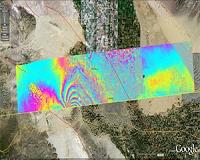| . |  |
. |
Paris (AFP) Oct 24, 2010 The January 12 earthquake in Haiti failed to release all the tension in a notorious seismic fault, leaving its capital exposed to the risk of another seismic disaster, US scientists reported Sunday. The magnitude 7.0 event, which killed a quarter of a million Haitians, occurred to the west of the capital Port-au-Prince. The culprit was initially thought to be a well-known but poorly understood fault called the Enriquillo-Plantain Garden Zone (EPGZ), where 7.0 quakes occurred in 1751 and 1770. The complex 270-kilometre (168-mile) -long fault runs along one of the narrow western prongs of the island of Hispaniola, which Haiti shares with the Dominican Republic. A team of geologists led by Carole Prentice, of the US Geological Survey (USGS) at Menlo Park, California, say assumptions that the EPGZ was to blame may be wrong. They carried out satellite imaging, aerial photography and boots-on-the-ground investigation to look for surface evidence of earthquakes along the fault. They found plenty of evidence of ground rupture, uplifted land and diverted streams that must have occurred in the 18th-century shakes -- but nothing similar that could be pinned to the 2010 event. While not unprecedented in seismology, this is highly unusual, for the January quake was very big and ocurred close to the surface. Prentice's team did some computer modelling to try to explain what could have happened. One suggestion is that the EPGZ did indeed slip, but at depth, while another is that the quake occurred on a "blind" sub-parallel structure. Either way, the visual observations and the computer models all indicate that the January quake did not ease the nearly two and a half centuries of accumulated strain at the EPGZ's surface. "The EPGZ remains a serious seismic hazard for Haiti, particularly for the Port-au-Prince area," warns the study, which is published online by the journal Nature Geoscience. It raised special concern over a 110-km (65-mile) stretch that runs from Lake Miragoane in the west to Dumay in the east, tracking just south of the Haitan capital. "These sections of the fault remain capable of generating an earthquake of up to 7.0 magnitude and, in the case of the Momance and Dumay sections, which are closer to Port-au-Prince, potentially causing stronger ground shaking in the urban area than the January 12 event." On October 10, a separate team of geologists, also publishing in Nature Geoscience, found that the January gave only "limited" release to the EPGZ. Calculating the pentup strain since the 18th century, they said "an earthquake larger than the 2010 is certainly possible" if the fault ruptured adjacent to Port-au-Prince. Neither study gave any indication of when this feared earthquake could occur. Seismologists say they are gaining more and knowledge about how earthquakes happen and are better at predicting the magnitude of some kinds of quakes. But pinpointing, even roughly, when these events will happen remains elusive.
Share This Article With Planet Earth
Related Links Bringing Order To A World Of Disasters When the Earth Quakes A world of storm and tempest
 California braces for the Big One, with fake quake
California braces for the Big One, with fake quakeBurbank, California (AFP) Oct 21, 2010 Choppers clattering in the sky above, bloodstained students watch in shock as blaring ambulances screech into the schoolyard, disgorging paramedics with medicine packs and gurneys. At least that's what it looked like, as one California school put on a graphic display Thursday of what will happen when - not if - the Big One hits this earthquake-prone western US state. Nearly eight mill ... read more |
|
| The content herein, unless otherwise known to be public domain, are Copyright 1995-2010 - SpaceDaily. AFP and UPI Wire Stories are copyright Agence France-Presse and United Press International. ESA Portal Reports are copyright European Space Agency. All NASA sourced material is public domain. Additional copyrights may apply in whole or part to other bona fide parties. Advertising does not imply endorsement,agreement or approval of any opinions, statements or information provided by SpaceDaily on any Web page published or hosted by SpaceDaily. Privacy Statement |